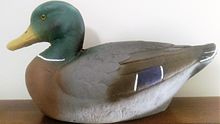
A thermoplastic, or thermosoftening plastic, is any plastic polymer material that becomes pliable or moldable at a certain elevated temperature and solidifies upon cooling.

The Brodie helmet is a steel combat helmet designed and patented in London in 1915 by Latvian inventor John Leopold Brodie. A modified form of it became the Helmet, Steel, Mark I in Britain and the M1917 Helmet in the US. Colloquially, it was called the shrapnel helmet, battle bowler, Tommy helmet, tin hat, and in the United States the doughboy helmet. It was also known as the dishpan hat, tin pan hat, washbasin and Kelly helmet. The German Army called it the Salatschüssel. The term Brodie is often misused. It is correctly applied only to the original 1915 Brodie's Steel Helmet, War Office Pattern.

The Stahlhelm is a German military steel combat helmet intended to provide protection against shrapnels and fragments or shards of grenades. The term Stahlhelm refers both to a generic steel helmet and more specifically to the distinctive German military design.

The M1 helmet is a combat helmet that was used by the U.S. military from World War II until 1985, when it was succeeded by the PASGT helmet. The M1 helmet has become an icon of the US military, with its design inspiring other militaries around the world.
Thermoforming is a manufacturing process where a plastic sheet is heated to a pliable forming temperature, formed to a specific shape in a mold, and trimmed to create a usable product. The sheet, or "film" when referring to thinner gauges and certain material types, is heated in an oven to a high-enough temperature that permits it to be stretched into or onto a mold and cooled to a finished shape. Its simplified version is vacuum forming.

The pith helmet, also known as the safari helmet, salacot, sola topee, sun helmet, topee, and topi is a lightweight cloth-covered helmet made of sholapith. The pith helmet originates from the Spanish military adaptation of the native salakot headgear of the Philippines.
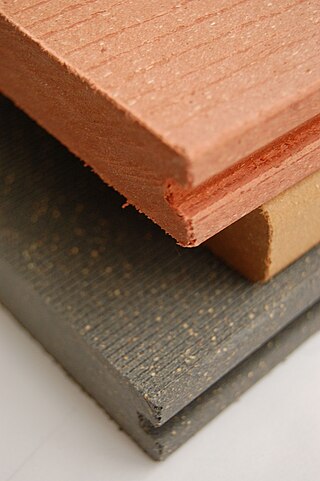
Wood-plastic composites (WPCs) are composite materials made of wood fiber/wood flour and thermoplastic(s) such as polythene (PE), polypropylene (PP), polyvinyl chloride (PVC), or polylactic acid (PLA).

Compression molding is a method of molding in which the molding material, generally preheated, is first placed in an open, heated mold cavity. The mold is closed with a top force or plug member, pressure is applied to force the material into contact with all mold areas, while heat and pressure are maintained until the molding material has cured; this process is known as compression molding method and in case of rubber it is also known as 'Vulcanisation'. The process employs thermosetting resins in a partially cured stage, either in the form of granules, putty-like masses, or preforms.
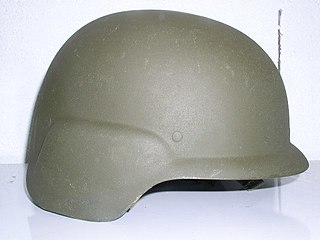
The SPECTRA helmet or CGF Gallet Combat Helmet is the PASGT-style ballistic helmet in use with the French military, and the armies of several other countries. Built by CGF Gallet, it weighs 1.4 kg (3.1 lb), is available in three sizes, and is made from ultra-high-molecular-weight polyethylene Spectra fibers, produced under license from Honeywell.

Jesse Barnum Hawley Jr. was an American football coach, inventor, and president of Hawley Products Company. He served as the head coach at the University of Iowa from 1910 to 1915 and at Dartmouth College from 1923 to 1928, compiling a career college football record of 63–28–1. Hawley was the tenth head coach in Iowa football history and led Dartmouth to a national championship in 1925. In 1935, Hawley invented a tropical shaped, pressed fiber sun helmet that was adopted in 1940 by the United States military. Approximately 250,000 of Hawley's military sun helmets were produced during World War II by Hawley Products Company and the International Hat Company.
The Bangtan Helmet is a combat helmet developed by South Korea in 1971. Despite the name, the helmet was not designed to withstand against direct hitting bullets but to protect against heavy objects and bomb shrapnel–a standard for 1970s military world wide; though, it was one of the earliest military helmets that applied non-metal composite material to reduce the weight while increasing the protection. The name was given as a commemorate for being superior than the M1 helmet. The helmet configuration is based on the latest version of the M1.
BrickArms is a limited liability company specializing in minifigure accessories, specifically weaponry. It is unaffiliated with LEGO, instead privately owned and operated by designer Will Chapman from his home in Redmond, Washington. The company was briefly the subject of controversy when one of its products was accused of being based on a member of al-Qaeda.
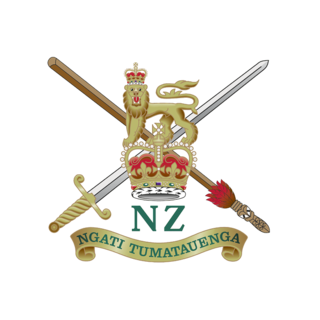
The New Zealand Army uniform has changed over the years from that of the original Armed Constabulary of the 1800s to the modern Army Combat Uniform style in use by the majority of world armies today. While British Army influence has always been strong, distinctive New Zealand features have gradually developed. From 2013 the New Zealand Army uniform underwent a complete redesign with a new and distinctive camouflage pattern unique to the NZDF.
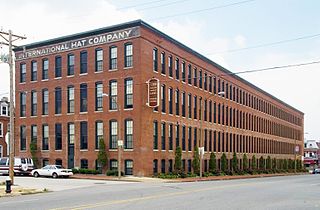
International Hat Company, formerly named the International Harvest Hat Company, was a St. Louis, Missouri-based manufacturer of commercial hats and military helmets. The company was one of the largest hat manufacturers in the United States and, at one time, the largest manufacturer of harvest hats in the world. It is best remembered for its design and mass production of tropical shaped, pressed fiber military sun helmets for service members of the United States Army, Marines, and Navy during and after World War II. Additionally, the American owned company was a major producer of harvest hats, straw hats, fiber sun hats, enameled dress hats, baseball caps, and earmuffs throughout most of the 20th century. However, it is the International Hat military sun helmets that have become the most notable collector's items.
Frank G. Pellegrino was an American engineer, inventor, and industrialist. He served as president of the General Fibre Company. During his tenure, General Fibre became the largest manufacturer of duck decoy models in the United States, producing over a million per year in the 1950s. Pellegrino also negotiated the sale of the International Hat Company to Interco, Inc. Additionally, he created a variety of inventions related to the plastic molding industry. Most notably, Pellegrino invented automated assembly line machines in the formation of plastic objects. These machines were used by General Fibre in the production of a variety of plastic models, duck decoys, and Michelob paraphernalia throughout the 1960s to 1980s.
Transfer molding is a manufacturing process in which casting material is forced into a mold. Transfer molding is different from compression molding in that the mold is enclosed rather than open to the fill plunger resulting in higher dimensional tolerances and less environmental impact. Compared to injection molding, transfer molding uses higher pressures to uniformly fill the mold cavity. This allows thicker reinforcing fiber matrices to be more completely saturated by resin. Furthermore, unlike injection molding the transfer mold casting material may start the process as a solid. This can reduce equipment costs and time dependency. The transfer process may have a slower fill rate than an equivalent injection molding process.
George Tilles Jr. was president of the International Hat Company during World War II. Under Tilles, International Hat become one of the two dominant manufacturers of fiber pressed military pith helmets for the United States Army, Marines, and Navy. The Tilles Memorial City Park in Oran, Missouri, is named in his honor.

The American fiber helmet is a type of sun helmet made of pressed fiber material that has been used as part of the military uniform by various branches and units of the United States Armed Forces from 1934 to the present day. As of 2017, the helmet continues to be worn by U.S. military rifle range cadres, as an icon for marksmanship excellence. The helmet is technically not a pith helmet, insofar as it is not constructed from pith material. However, in the more generic sense of design style, this type of sun helmet is modeled similarly to one and thus often referred to in common use as a pith helmet. Additionally, the helmet is not a combat helmet, insofar as it was not originally designed to protect the head during combat. However, the helmet was nonetheless assigned, at various times in the 1930s and 1940s, as combat gear for use in active theaters.

Hawley Products Company is a manufacturer of loudspeaker components. The company is the oldest manufacturer of loudspeaker diaphragms in the world. Historically, the company produced a variety of products composed of fibrous or plastic materials, including helmets, globes, microwave trays, automotive components, suitcases, and furniture. Most notably, the company is remembered for its World War II military helmets and helmet liners used by soldiers in the United States Army, Marines, and Navy. Hawley Products is the original designer of the M1 steel helmet liner. The company is also one of the two original manufacturers of the M1 steel helmet liner, alongside General Fibre Company. Additionally, Hawley Products designed and manufactured several versions of the pressed fiber military sun helmet used by the US military during World War II. The military continued to use this sun helmet throughout most of the 20th century, including Naval personnel during the Persian Gulf War.

The Gefechtshelm M92 is the standard issue combat helmet of the Bundeswehr, first fielded in 1992 as a replacement of earlier M1956 steel helmets that were previously used during the Cold War. It is made from Aramid composite materials and is used by all branches of the Bundeswehr.
